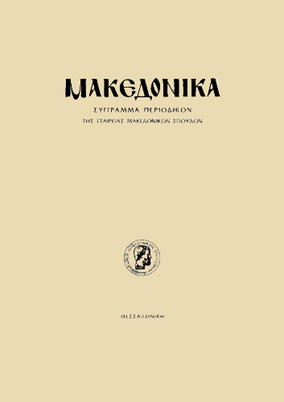Συμβολή στην κατανόηση της εθνικής ταυτότητας της εσωτερικής μακεδονικής επαναστατικής οργάνωσης (1893-1912)
Part of : Μακεδονικά ; Vol.33, 2002, pages 77-105
Issue:
Pages:
77-105
Parallel Title:
Contribution to the understanding of the ethnic identity of the Internal Macedonian Revolutionary Organisation (1893-1912).
Section Title:
Articles
Abstract:
The identity of the Internal Macedonian Revolutionary Organisation (IMRO, est. 1893) has been a contested historiographical issue. Its leading members, such as Gotse Delchev, Damyan (Dame) Gruev and Jane Sandanski, are claimed by the Bulgarian and the Slav-Macedonian historiography as Bulgarian and Macedonian nationals respectively. I have argued that these claims serve a nationalist agenda: the historical substantiation of Bulgaria’s irredentist claims on Ottoman Macedonia, and the consolidation of a modern Macedonian nation-state respectively. For that matter, the Ilinden uprising (20 July/2 August 1903) is illustrated by Bulgarian historical studies as the epit ome of the Bulgaro-Macedonian population’s struggle for liberation of Mace donia from Ottoman yoke, whereas the historiographical output released at Skopje considers it as a blueprint for the establishment of a Macedonian People’s Republic forty years later, on 2nd August 1944. In the event, Greek historians, along with Serbian and Coat émigrés, have by and large sided with the Bulgarians, and denied the existence of a Macedonian nation as such. For its part, Western historiography, even though inclined towards the Bulgarians in the inter-war period, after the Second World War has mainly supported the Slav-Macedonian claims. I have maintained that the Western historiographical perspective is preposterous, lacks an adequate reading of primary sources, and is marred by inconsistency, contradictions and sim plification. In certain cases, for instance the pertinent monographs by Duncan Perry (1988) and Nadine Lange-Akhund (1998), the attribute “Bulgarian”, found in IMRO’s statutes and documents, are ignored, and arbitrarily substi tuted by “Macedonian” in the national sense. Political and anthropological studies published after the break-up of Yugoslavia in the 1990s are more openly pro-Macedonian. In my opinion, most helpful is the work of Fikret Adanir (1979): he arguably points out that IMRO’s ethnic identity is a rather “complicated” issue yet on the basis of diplomatic reports its Bulgarian character is more or less evident. For a better understanding of IMRO’s identity, most enlightening is Ivo Banac’s point that there is a dichotomy between its pre- and its post-First World War nature. Whereas in the late nineteenth and the early twentieth century it was a more or less Bulgarian nationalist/irredentist institution, in the post-war period certain splinters gradually acquired a Macedonian national character. Researching British diplomatic reports preserved at the National Archives (formerly Public Record Office), as well as the memoirs of an American traveller who lived with IMRO’s rebels at the time, the pre-war (1893-1912) identity of IMRO can be historically established as Bulgarian. Drawing on Vlassis Vlassidis’ arguments, I have suggested that the frustration of Bulgarian irredentist/expansionist endeavours in Ottoman Macedonia following Bulgaria’s utter defeat in the Second Balkan War and in the First World War, in conjunction with increasing Communist influence on IMRO cadres after 1923 led to the political re-orientation of Macedonian Slavs and their search for a new identity. In October 1925, IMRO (United) was esta blished in Vienna professing the rights of Macedonian nationals. In 1934, the Macedonian Slavs were recognised by Comintern as a distinct nation (narod). For this reason, 1918 may be established as terminus post quern factions of IMRO underwent an irreversible process of “Macedonianisation”.
Subject:
Subject (LC):
Notes:
856:https://ejournals.epublishing.ekt.gr/index.php/makedonika/article/view/5841, DOI: https://doi.org/10.12681/makedonika.280
Electronic Resources:




